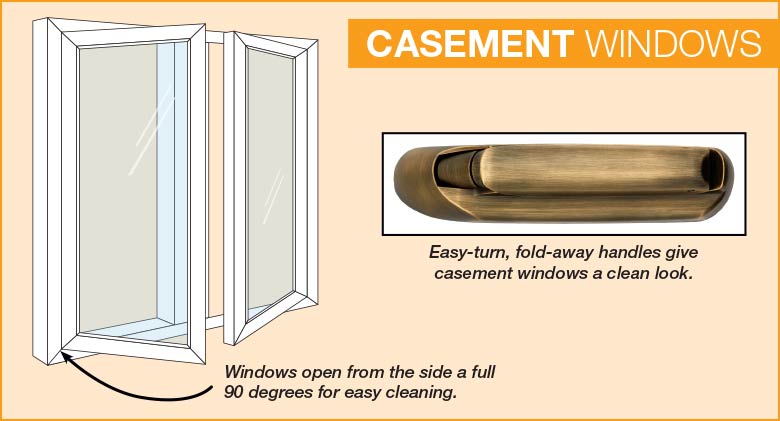
In this post you’ll learn …
- The physical differences between sliding and casement windows.
- What to look for in quality casement or sliding windows.
- The best locations in your home for sliding and casement windows
Vinyl replacement windows not only improve the appearance of your home, but they also make your home more energy efficient. The result is a cooler home during the summer and a warmer home during the winter. A replacement window can be chosen from a wide assortment of options and is installed into an existing window opening, though that window opening can be modified to accommodate a different size or type of window. In this blog post, we’ll help you learn the differences between casement and sliding windows.
The Differences Between Sliding Windows and Casement Windows
Sliding windows and casement windows are both great options for any home, but there are some differences between the two windows:
Physical Differences

When it comes to your home’s replacement windows, the dimensions of your window opening will influence your decision. Sliding windows are used in openings that are wider than they are tall. They open sideways, with one pane sliding over the other. Sliding windows are easy to operate, durable and low maintenance. In Stanek sliding windows, the sashes easily lift out of the frame making them easy to clean. Sliding windows come in two configurations. Two-lite sliding windows have two sliding sashes, while three-lite sliding windows have a fixed or picture window in the center, with a sliding sash on each side of it.

Casement windows, also known as crank windows, are often chosen for tall, narrow window openings. The windows are attached to the side of the window frame and swing outward. Casement windows are opened and closed with a crank, handle, or lever, making them easy to open close. Stanek’s unique design allows the windows to be opened to a 90-degree angle allowing for easy cleaning from the interior of your home. Casement windows come in a variety of configurations, from one-lite to five-lite, with or without a fixed window in the center.
Window Ventilation
 There is a difference in how air flows through the openings, based on how each window type is built. Most casement windows open completely, so air can pass through the entire opening. With typical sliding windows, half the window space is closed or overlapping, so the windows provide less ventilation. Stanek® sliding windows, however, are built to allow both panes to be opened at the same time, allowing for maximum ventilation from a sliding window.
There is a difference in how air flows through the openings, based on how each window type is built. Most casement windows open completely, so air can pass through the entire opening. With typical sliding windows, half the window space is closed or overlapping, so the windows provide less ventilation. Stanek® sliding windows, however, are built to allow both panes to be opened at the same time, allowing for maximum ventilation from a sliding window.
Energy Efficiency
Both replacement sliding and casement windows are energy efficient, but there is a difference between the two options. Since a sliding window must pass over the track when it opens and closes, the seal must be somewhat flexible. A casement window seal is not flexible. When a casement window is closed and locked, the locking mechanism pulls the window sash to the frame, creating an airtight seal. While both replacement window options are energy efficient, casement windows are more energy efficient since they are not flexible by design.
What to Look For In Quality Sliding or Casement Windows

The opening you have for your window space will help you determine what type of replacement window you need. Both sliding and casement windows can fit spaces that are wider than they are tall, though casement windows can also be used for taller, narrow spaces. Both windows would work well above a kitchen sink where the reach would make it difficult to open a double-hung window. Be sure to look at your space from the exterior of the home as well. A sliding window won’t obstruct walkways or decks the way a casement window can when it’s open.
When you are looking for replacement windows, make sure the company you choose has quality windows and will provide you with all of the information about your new windows. For example, some sliding windows can be difficult to open, but Stanek® sliding windows feature reinforced sashes, dual sliding shoes, and fully integrated lift rails so they operate effortlessly, are durable, and secure.
Stanek casement windows have multi-chambered frames with super-insulated foam for maximum insulation. Stanek® casements also open to a full 90-degree angle, providing maximum airflow into your space. This unique feature also makes it very easy to clean the windows.
Stanek® replacement windows are made in the USA and are built to fit your home. They provide your family with custom options at a price you can afford. If you’re looking for high-quality, energy-efficient windows that will add value to your home, schedule a free in-home estimate online or call us at 1-800-230-8301.
 You May Also Be Interested In:
You May Also Be Interested In: